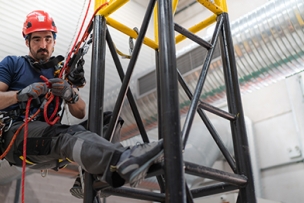OSHA’s Ladder Regulations
Ladder safety is clearly no small matter. The question is: How can employers avoid the related injuries and costs?
If your business is covered by OSHA on the federal or state level and your workers use ladders, it’s your responsibility to follow ladder training and safety standards. Doing so can help you protect your workers and avoid costly workplace injuries.
Read more: Safety Tips for CNC Machinists: 5 Must-Know Rules for the Workplace
OSHA’s general industry requirements for employer ladder safety are covered in standard 1910.23, which describes the physical attributes and restrictions on use for various types of ladders. The standard offers general requirements for all ladders, and specific requirements for portable ladders, fixed ladders and mobile ladder stands and platforms.
The standard also describes how to set up these ladders and how to use them, such as avoiding placing ladders on boxes or other unstable bases to obtain additional height.
Separately, the American National Standards Institute (ANSI) issues safety standards for the ladder industry: technical specifications that prescribe rules governing the safe construction, design, testing, care and use of various types of ladders.
Ladder safety begins with selecting the correct ladder for the job at hand, inspecting the ladder for any defects, setting it up correctly, and then using the ladder appropriately (using proper techniques for climbing and standing), and finally, employing the correct care and storage practices.
In addition to the general safety rules outlined by OSHA and others, ladder users should rely on common sense when using ladders on a job site. Here are some tips to keep in mind that can help minimize the risk of most ladder accidents:
Tip No. 1: Inspect and Maintain Your Ladders
Keeping your ladders in good shape is vital for ensuring your employees remain safe. According to OSHA, ladders should be “maintained free of oil, grease, and other slipping hazards.” They should also be inspected “by a competent person for visible defects on a periodic basis and after any occurrence that could affect their safe use.”
Ladders with structural defects (such as missing rungs, cleats or steps, or loose parts) or other faulty components should be marked as defective or tagged as “not usable” or “dangerous—do not use” until repaired or destroyed, OSHA says. A ladder should only be used again after it has been restored to its original condition.
In fact, the American Ladder Institute (ALI) notes that “no attempt shall be made to repair a ladder with a defective side rail” and that “ladders with bent or broken side rails must be destroyed.” The ALI adds that a ladder that has been discarded “must be destroyed in such a manner as to render it useless,” because “another person must not be given the opportunity to use a ladder that has been deemed unsafe.”
Tip No. 2: Keep Your Employees Informed
OSHA’s rules governing ladder use can be complicated and difficult to remember. For example, OSHA requires that an employer place ladder rungs, steps and cleats no less than 10 inches and not more than 14 inches apart, as measured between the centerlines of the rungs, cleats and steps.
OSHA’s requirements for ladder height, angle and spacing are very technical, too, and for this reason you should make sure all the relevant rules and regulations about ladders are readily available to your workers. It’s also important to update employees about any changes to the rules, or how to locate that information if they need it.
Being informed is half the battle won when it comes to ladder safety. So making information about safe ladder use available to your workers is an important step in ensuring their risk of injury is minimized.
Read more: COVID-19 Social Distancing: Technologies and Tactics to Keep Your Workers Safe
Tip No. 3: Respect Ladder Limitations
While a ladder is often the only practical tool for performing certain work tasks, it has its limitations.
For example, placing a ladder in certain high-traffic areas—passageways, doorways or driveways—can lead to its accidental dislocation and likely injuries to users. OSHA notes that ladders in use should not be moved, shifted or extended, and that the “top or top step of a stepladder shall not be used as a step”—all actions that would likely put the user at greater risk of injury.
And a ladder is only capable of withstanding a certain amount of weight before it could fail. OSHA stipulates that ladders should not be “loaded beyond the maximum intended load for which they were built, nor beyond their manufacturer’s rated capacity.”
Each ladder should have a “duty rating” that can be found on its specifications label. This is the maximum weight that a ladder can safely carry, and it should be greater than the total amount of weight your ladder will be supporting, including the worker’s weight, the weight of any clothing and protective equipment he or she is wearing, the weight of the worker’s tools and supplies, and any tools that may be attached to the ladder itself.





Talk to Us!
Leave a reply
Your email address will not be published. Required fields are marked *